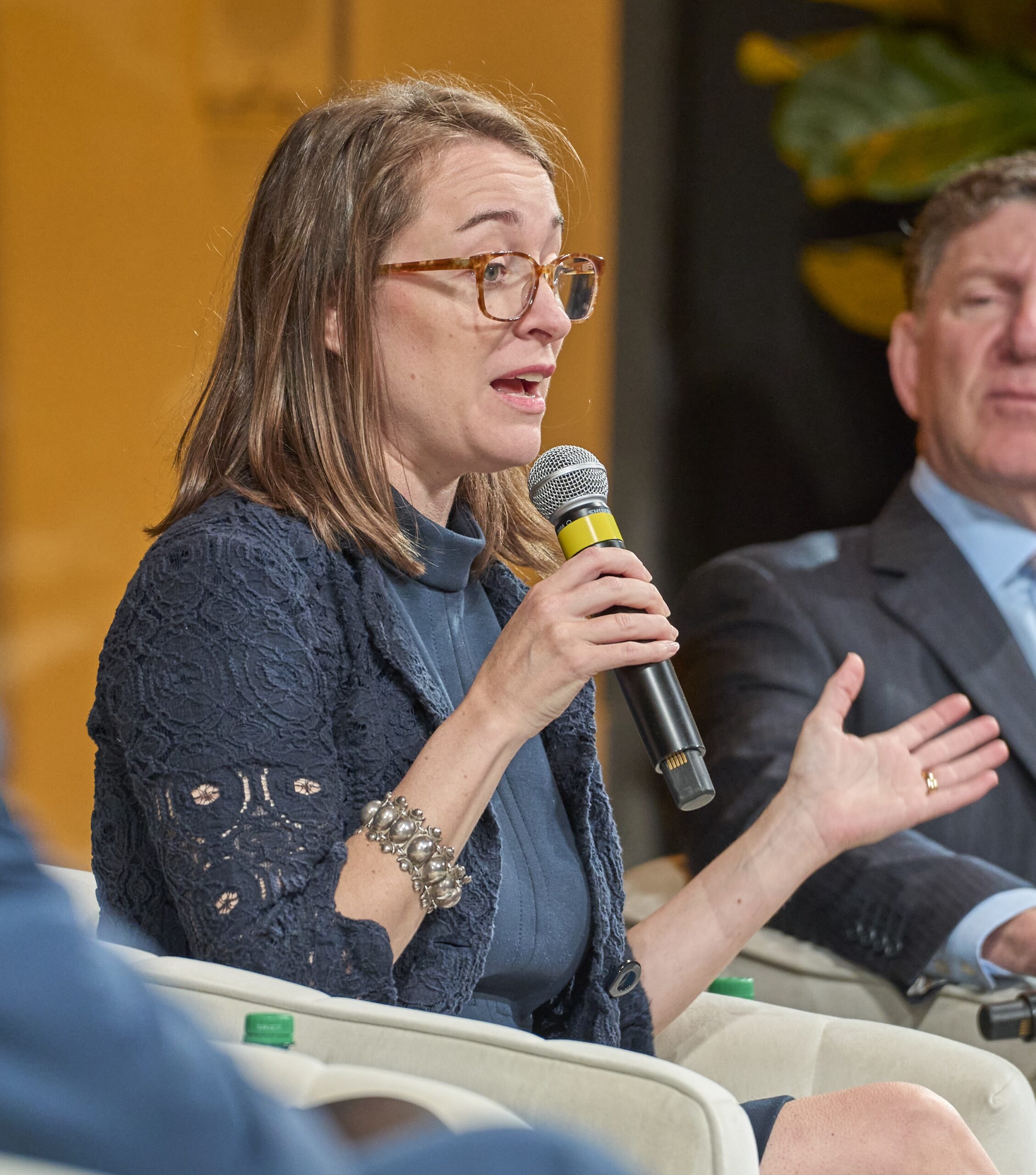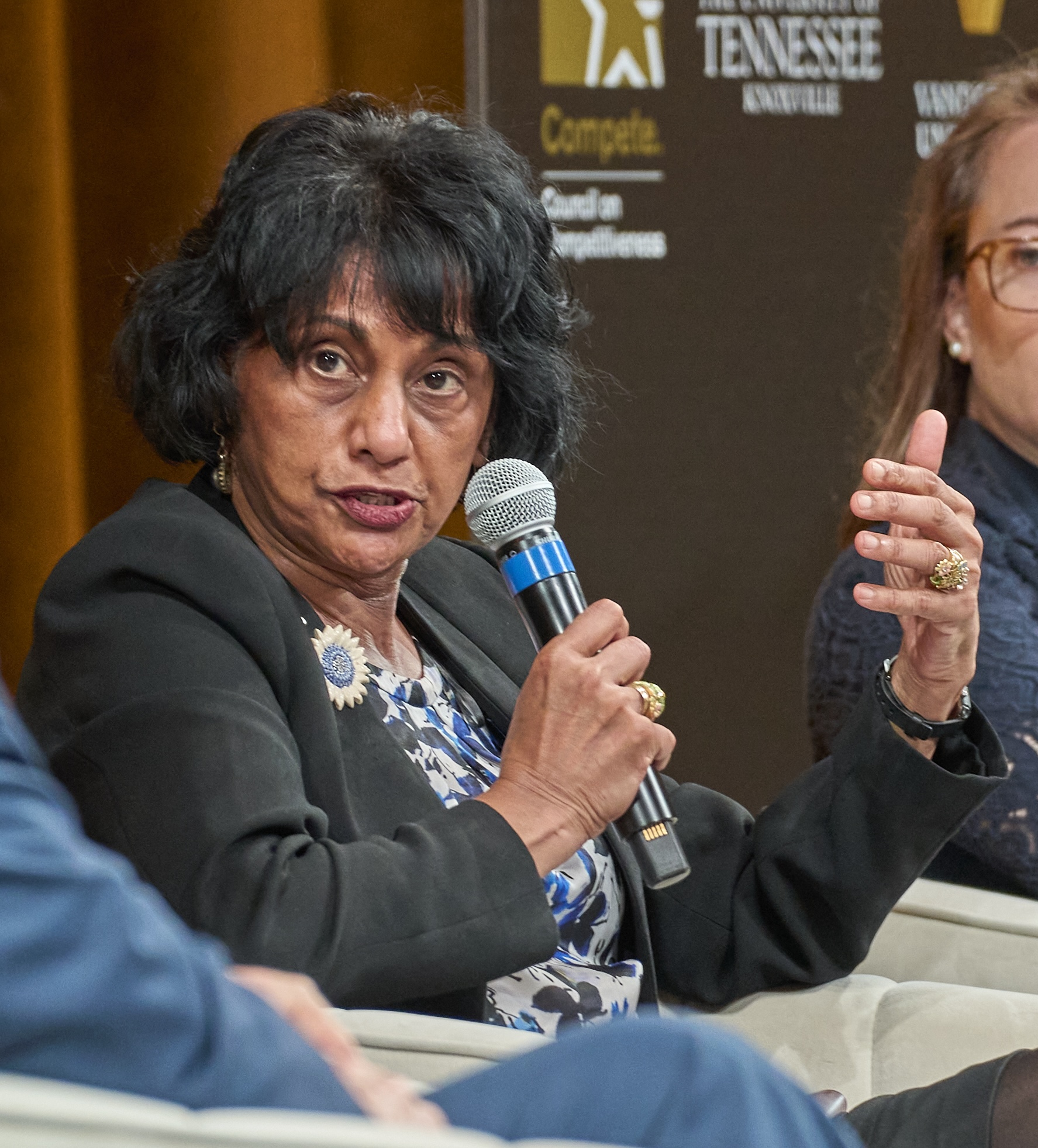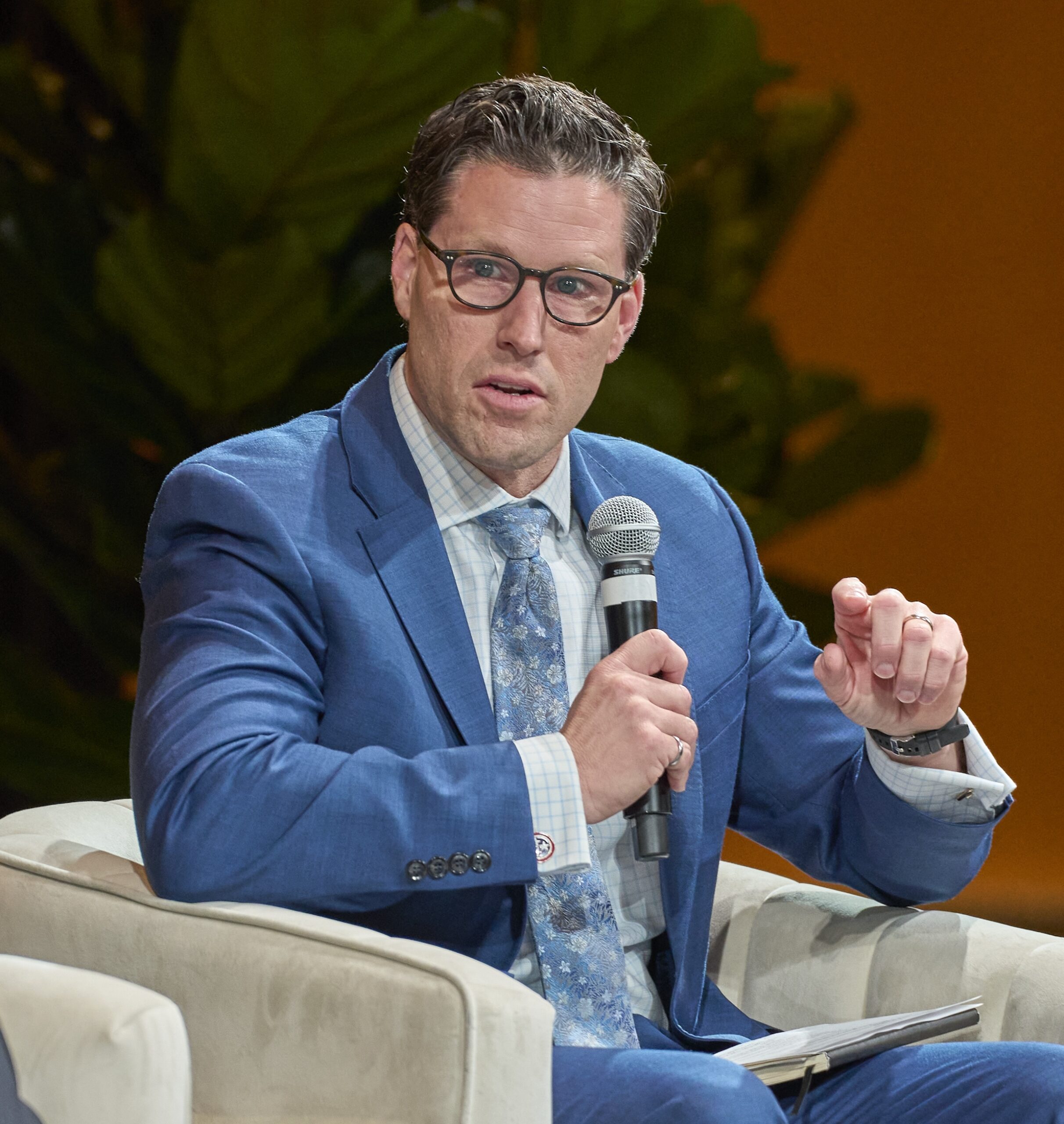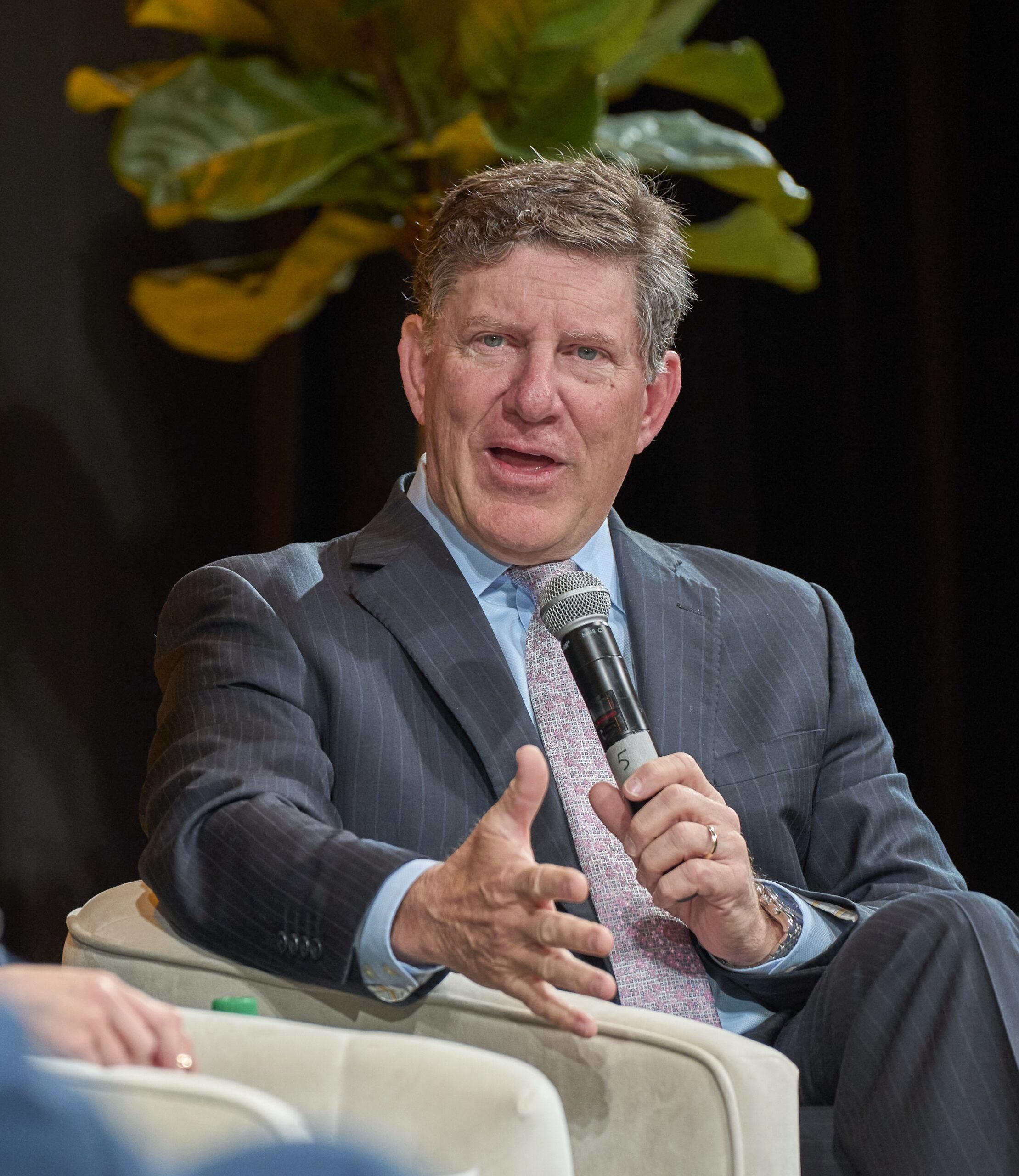Overview
Perhaps no industry underpins the U.S. economy more critically than the energy sector. Keeping Tennessee, and the rest of the country, powered will be a crucial challenge, especially as demand surges and legacy fossil fuel plants phase out in favor of a lower-carbon energy mix. Led by Chad Holliday and consisting of participants across the energy sector, from researchers to producers to consumers, this panel explored the future of the Tennessee energy grid, its criticality to the growth of the state’s economy, and what steps are needed to keep it dependable and sustainable.
Key Session Insights
Council Chair Emeritus Chad Holliday kicked off this panel by sharing an insight from U.N. Secretary General Ban Ki-moon: energy is the “golden thread” that connects every facet of modern life. Historically, a robust power grid has been a major competitive advantage for the United States, serving as a reliable foundation on which the nation has built a modern economy and a robust middle-class workforce. The consistency and availability of power across the country has been taken for granted for the better part of a century, owing in large part to the Rural Electrification Act of 1936. With virtually all U.S. homes and businesses connected to the grid, generation infrastructure expanded exponentially, allowing for unprecedented growth, both economically and in quality of life.

“I asked U.N. Secretary General Ban Ki-moon, with all the wars and conflicts going on, how do you find time to focus so much of your personal attention on energy? He had a very simple answer. When nations have a modern effective energy system, you do not have all those wars and conflicts. He was working on the root cause.”
Chad Holliday
Chair, Global Federation of Competitiveness Councils; Co-Chair, Mission Possible Partnership; Chair Emeritus, Royal Dutch Shell; Chair Emeritus, Council on Competitiveness
However, the nation—and states like Tennessee in particular—is facing an unprecedented challenge: economic and population growth are beginning to outpace the supply of electricity. The growth of data centers and the electrification of many sectors, notably transportation, has also been a major contributor to this new dynamic. Over the past 70 years, according to TVA President and CEO Jeff Lyash, electricity has grown from two percent of the energy Americans use to 22 percent, and it is expected to hit the 50 percent level by mid-century. Further, this increase in demand coincides with the push to redesign the energy system to dramatically reduce its carbon emissions. These challenges cannot be met with a business-as-usual approach to meeting demand growth; a radical rethink and retooling of the state’s energy infrastructure and strategy is needed if the power grid is to remain a regional strength. The same is true in many regions across the country. Without such an effort, the grid that has served as the stable bedrock of the American economy and way of life may not be able to meet demand, jeopardizing a century of progress and putting future growth in question.

A significant portion of this growth in power demand is coming from the expansion of data centers. For example, the computers required to train and operate AI systems and run modern big-data calculations consume small cities’ worth of power; according to ORNL Director Stephen Streiffer, the lab’s Frontier computer uses as much energy as the city of Oak Ridge itself. Without close alignment between large energy users, like Oak Ridge or Google, and the utilities that supply them, the growing demand on the energy grid could quickly become unsustainable and limit a region’s economic growth. But with long-term planning and vision, the potential of AI, proper partnerships, and robust investments across a multitude of strategic electricity production and efficiency solutions, the energy needs of the growing number of data centers can be met.
Building partnerships between energy producers and consumers is vital for getting the most out of our energy system. With the spike in demand for power from industry, communication and collaboration from all industry stakeholders is essential. And that starts with understanding both what energy consumers need and what energy producers can put on the grid affordably and reliably, and what constraints there are. This two-way communication allows for the dynamic shifting of loads and investments in innovative infrastructure that requires less energy or can deliver electricity more efficiently. Collectively, these efforts can lessen demand and the premature need for generation expansion, affording utilities more room to maneuver. As an example from the panel, Google Southeast Energy and Policy Lead Katie Ottenweller and TVA President and CEO Jeff Lyash discussed how closely they work together to match their energy needs, both today and in the future. Having a clear understanding of the energy that TVA can produce affordably, reliably, and cleanly helps Google plan for how it operates in the region.

“We must invest in technologies that are not yet mature. Looking ahead 5-20 years toward a fully decarbonized future, we are going to need long-duration energy storage, fusion, geothermal. At Google, we are signaling that we have demand for these technologies to trigger investment and commercialization.”
Katie Ottenweller
Southeast Lead for Energy Policy & Markets, Google
In addition to increasing communication and collaboration, the panel discussed how meeting the growing energy demand requires everyone, and every energy user and producer has a deep responsibility to help meet it. And that’s especially true for businesses. As the push to transition to a lower-carbon-emission electrical system intensifies, the transition away from fossil fuels must be done in a way that does not undercut the reliable and abundant power supply Tennessee relies on. Businesses and other large organizations are among the heaviest consumers of electrical power and so have a responsibility to increase their energy efficiency to both lower costs and improve the energy resilience of the region.
Fortunately, these challenges are beginning to be faced. For example, according to Google’s Ottenweller, the company’s Tennessee infrastructure is serving as a leader in efficient computing, getting 1.5 times more computing power per watt than a standard data center, and still improving. By working to decrease their needs, businesses will not only lower their own costs, but also better serve the environment and help lessen the strain they place on the grid.
But what role do individuals have? The panel discussed how consumers can use technology to moderate their power usage, which collectively could have a big impact on energy demands on the grid. One bridging technology allowing for the increased efficiency is demand response, which softens spikes in peak energy demands on the grid. But consumers will only adapt and implement these technologies if they feel it is worthwhile from a financial and/or a sustainability perspective.
Consumers also wield power through politics and litigation, including around major infrastructure projects like the expansion of the grid. TVA’s Lyash reported the overwhelming amount of litigation TVA faces for any new expansion project they work to undertake. One partial solution the panel discussed was increasing consumer education. Through education about the benefits of demand response technologies, like smart thermostats and expanded energy infrastructure, cities and utilities can work more nimbly to modernize the grid in Tennessee and beyond.
In the short term, communication and efficiency gains can help utilities keep pace with growing energy needs, but profound innovation in electricity generation is needed to meet the ever-growing energy demand. New technologies, such as advanced solar, long-term energy storage, and even nuclear fusion have the potential to alter radically the energy production landscape. Few expect the energy mix of the future will closely resemble that of the past, or even today.
Much of the work to bring these new technologies to fruition is being done at universities and the DOE National Laboratories, in Tennessee at Oak Ridge National Laboratory and sister labs across the country. Innovations from these research institutions are keys to the energy grid of the future. Investment, a long-term vision, and proper planning is needed to implement these new technologies at the scale and pace needed to support the transition.

“Unless we get fusion, unless we get fission, and unless we get renewables onto the grid, I start to fear about tipping points in climate, where we see dramatic climate changes that are just incredibly disruptive to the way we live in the world, to food production, to water production and utilization—all of the things that have kept the world at peace for the last decades.”
Stephen Streiffer
Director, Oak Ridge National Laboratory
And this capacity has already been recognized. Vanderbilt University’s Vice Provost for Research and Innovation Padma Raghavan highlighted how the TVA and Nashville Electric Service are already working with Vanderbilt and the University of Tennessee, Knoxville, to do two things: first, to invest in green infrastructure: and second, to research how to deploy green technologies. The intentional focus on these partnerships was represented across the panel, a demonstration of how seriously stakeholders across the state and region take these relationships.

“Tennessee is the Volunteer State, but we are also the partnership state. And we are also pioneers. I think we can get ahead of these (energy) challenges, and I think we will work together to do that.”
Padma Raghavan
Vice Provost for Research and Innovation, Vanderbilt University
But as important as new energy discoveries and technologies are to our future, scaling unproven technologies in a meaningful way requires enormous, high-risk investments. To make the energy transition happen, new projects and technologies need to become attractive to investors. The DOE National Laboratories play a critical role in de-risking technologies by taking on much of the initial research and development work, and they can spur large-scale investment via public-private partnerships. ORNL Director Streiffer made it clear how central he saw de-risking new technologies to the lab’s mission.
But the DOE National Labs are not the only ones with a role to play in de-risking technology for investment. With a more local focus and direct accountability to residents, public power companies have the potential to pioneer the adoption of new energy strategies that benefit residents. Ninety years ago, the founders of the TVA created the organization under the philosophy that affordable, reliable, and clean power can fundamentally improve the lives of people in a community. With this as their yardstick of success, public utilities like TVA often have more freedom to experiment than profit-driven private utilities and can consider more community welfare factors when judging the merits of a policy or strategy. As CEO Lyash noted: “We need to figure out how to share that risk and/or bring risk profiles down so that capital markets are able to drive innovation within their risk appetite. This will require alignment among industry, research, academia, government policy, and capital markets.”
Lyash put the utility’s three-part mission of energy, economic development, and environment front and center, highlighting their commitment to community betterment. Nonprofit, government-owned utilities, like the Nashville Electric Service (NES), can play a similar role, with a scope of responsibility more explicitly linked to public welfare than that of a for-profit utility. Public power companies often serve as laboratories of the energy transition, pushing the boundaries of what is possible.
Entities like the TVA and the NES have already begun to show how quickly they can move, with NES Chief Customer and Innovation Officer Brent Baker highlighting the utility’s partnerships that have catapulted Nashville to being the second biggest adopter of renewables in the Tennessee Valley. These sorts of investments will pay dividends in the long run as utilities test what is feasible today, and as consumers and society begin to see the benefits.

“We need to get out of the ‘what will not work’ mindset and think more openly about what is possible.”
Brent Baker
Vice President—Chief Customer and Innovation Officer, Nashville Electric Service
When making investments, TVA’s Lyash warned that we should not let the “perfect” solution be the enemy of the good. When discussing these strategies for modernizing the energy system, the merits of one new technology or energy source are often debated and contrasted with those of another to determine which is worth investment. While debating and discussing methods of renewable energy is laudable, the exercise misses a key point: multiple technologies and strategies, working in concert, are needed to expand successfully our energy production capabilities, and to make them cleaner and more resilient.
Renewables, such as wind and solar; novel nuclear designs; ideas for greater grid efficiency; natural gas as a bridge energy source; long-term energy storage; and even future fusion power are all on the table for discussion as pathways to curb emissions and build capacity and reliability. But each strategy or technology has its own bespoke use cases and restrictions on implementation. And each region requires its own energy mix based on its distinctive characteristics. For example, solar may be ideal in one part of a state but completely uneconomical in another. Rather than trying to find a single “best” solution, investing money across the board is more likely to yield long-term results—balancing, of course “letting a thousand flowers blossom” and achieving true, strategic, critical mass and results. This panel discussed nuclear, solar, efficiency gains, and more as means to strengthen the Tennessee energy system; putting all of them to work and more in a strategic way is what is needed.

“The world agenda will be shaped by the strongest economy. The future strength of any economy depends on the strength of its energy system. So, energy is critical to talking about international competitiveness.”
Jeff Lyash
President & CEO, Tennessee Valley Authority



